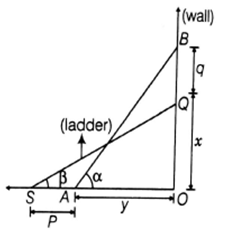A ladder rests against a vertical wall at an inclination α to the horizontal. Its foot is pulled away from the wall through a distance p, so that its upper end slides a distance q down the wall and then the ladder makes an angle ![]() to the horizontal, show that
to the horizontal, show that  =
= .
.
Let QO = x and given that BQ = q, such that BO = q+x is the height of the wall.
Let AO = y and given that SA = q.
∠BAO = α and ∠QSO = β

In ∆BAO,
![]()
![]()
⇒ BO = AB sin α …eq. 1
![]()
![]()
⇒ AO = AB cos α …eq. 2
In ∆QSO,
![]()
![]()
⇒ QO = SQ sin β …eq. 3
![]()
![]()
⇒ SO = SQ cos β …eq. 4
Subtracting eq. 2 from eq. 4, we get
SO –AO = SQ cos β – AB cos α
⇒ SA = SQ cos β – AB cos α
[from the above figure, SO –AO = SA = p]
⇒ p = AB cos β – AB cos α
[∵ SQ=AB=length of the ladder]
⇒ p = AB (cos β – cos α) …eq. 5
And subtracting eq. 3 from eq. 1, we get
BO –QO = AB sin α – SQ sin β
⇒ BQ = AB sin α – SQ sin β
[from the above figure, BO –QO = BQ = q]
⇒ q = AB sin α – AB sin β
[∵ SQ=AB=length of the ladder]
⇒ q = AB (sin α – sin β) …eq. 6
Dividing eq. 5 and eq. 6, we get
![]()
![]()
Hence, proved.